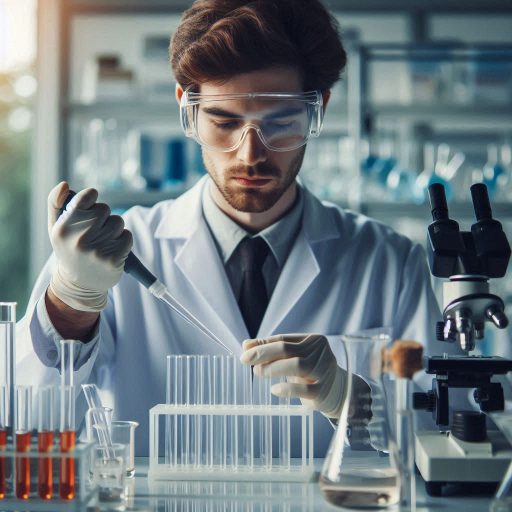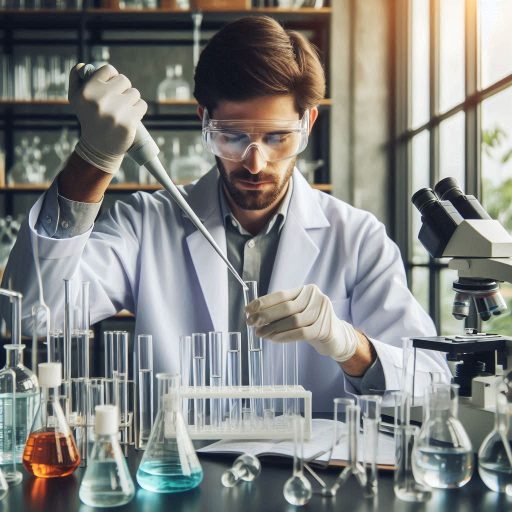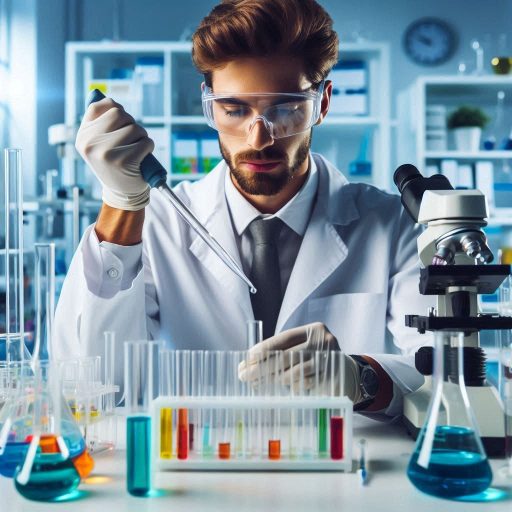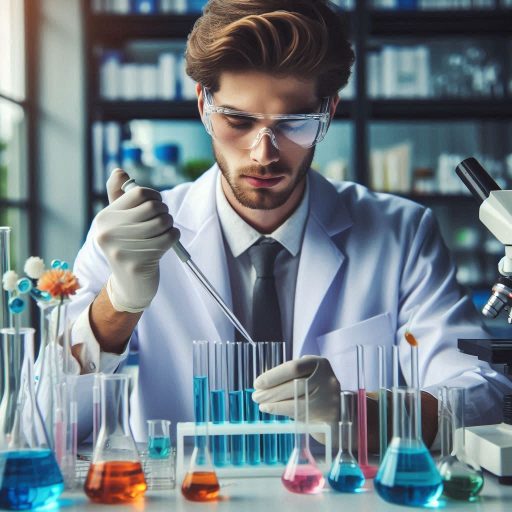Introduction
Laboratory safety is crucial for technicians working in environments filled with potential hazards.
Ensuring safety isn’t just about avoiding accidents; it‘s about creating a culture of vigilance and responsibility.
Laboratory technicians face daily risks, including exposure to harmful chemicals, biological agents, and dangerous equipment.
By adhering to established safety protocols, technicians can protect themselves and their colleagues from injury and ensure a safe working environment.
Brief Overview of the Importance of Laboratory Safety for Technicians
Laboratory safety is a vital component of any research or diagnostic facility.
Technicians are at the frontline, handling hazardous materials and sophisticated equipment, making their role in maintaining safety paramount.
Accidents in the lab can have severe consequences, ranging from minor injuries to life-threatening situations.
The importance of safety in the laboratory cannot be overstated, as it directly impacts the well-being of every individual in the lab and the accuracy of the work being conducted.
Technicians must be aware of the potential risks and the safety measures that can mitigate these risks effectively.
How Accidents Can Be Prevented by Following Safety Guidelines
Preventing accidents in the laboratory is achievable through strict adherence to safety guidelines.
These guidelines are designed to minimize risks associated with handling dangerous substances, operating complex machinery, and performing intricate procedures.
Proper training in safety protocols is essential for all technicians, as it equips them with the knowledge to recognize hazards and respond appropriately.
Wearing personal protective equipment (PPE) such as gloves, goggles, and lab coats is a fundamental aspect of laboratory safety.
Additionally, maintaining an organized workspace reduces the likelihood of accidents caused by clutter or misplaced items.
Regularly inspecting equipment and ensuring that safety devices are functional also play a critical role in accident prevention.
By following these guidelines, technicians can significantly reduce the occurrence of accidents and maintain a safe laboratory environment.
Wear Proper Personal Protective Equipment (PPE)
Personal protective equipment (PPE) is essential for laboratory safety.
Technicians must wear the appropriate gear to protect themselves from potential hazards.
The use of PPE is a critical practice that minimizes the risk of accidents and exposure to harmful substances.
Each piece of PPE serves a specific purpose, and its proper use can significantly reduce the chances of injury.
List of Essential PPE Including Gloves, Safety Goggles, Lab Coat, and Closed-Toe Shoes
The primary pieces of PPE for laboratory technicians include gloves, safety goggles, lab coats, and closed-toe shoes.
Gloves are crucial for protecting your hands from chemical spills, biological agents, and other hazardous materials.
Safety goggles shield your eyes from splashes, chemical fumes, and flying debris that may cause serious damage to your vision.
A lab coat acts as a barrier between your skin and dangerous substances, preventing direct contact with your clothing or body.
Closed-toe shoes are vital to protect your feet from spills, dropped equipment, and other potential injuries that could occur in the lab.
Wearing these items ensures you are prepared to handle the various risks present in a laboratory environment.
How Each Item Protects Against Different Hazards in the Lab
Each piece of PPE provides protection against specific laboratory hazards.
Gloves protect your hands from corrosive chemicals, biohazards, and other dangerous materials that could cause skin irritation, burns, or infections.
Safety goggles are essential in preventing eye injuries from splashes of chemicals, broken glass, or other particles that might fly into the eyes.
The lab coat is designed to protect your body and clothes from spills and splashes, reducing the risk of burns, stains, and exposure to harmful substances.
Closed-toe shoes offer protection from physical hazards like falling objects and chemical spills that could cause injuries to your feet.
By using the right PPE, technicians can significantly lower the risks associated with handling hazardous materials in the lab.
Importance of Ensuring the PPE Fits Properly and Is in Good Condition
The effectiveness of PPE depends on proper fit and condition.
Ill-fitting gloves, safety goggles, or lab coats can compromise your safety, leaving you vulnerable to potential hazards.
Gloves that are too loose can catch on equipment or tear easily, while tight gloves can restrict movement, leading to accidents.
Goggles that do not fit snugly may allow chemicals or particles to enter the eyes, while an improperly sized lab coat may expose skin to dangerous substances.
Additionally, PPE must be in good condition; worn-out or damaged equipment can fail when you need it most.
Regularly inspecting your PPE for wear and tear and replacing items as necessary is crucial to maintaining a safe laboratory environment.
Ensuring your PPE fits well and is in good condition helps you stay protected while performing your duties as a laboratory technician.
Follow Standard Operating Procedures (SOPs)
When working in a laboratory, following Standard Operating Procedures (SOPs) is crucial for ensuring safety and preventing accidents.
Importance of reading and understanding SOPs before conducting experiments
Before starting any experiment, technicians should carefully read and comprehend the SOPs provided by the laboratory.
This is essential for understanding the proper steps and precautions necessary for conducting the experiment safely.
How SOPs outline safe practices and emergency procedures in case of accidents
SOPs serve as a detailed guide that outlines safe practices, protocols, and emergency procedures that should be followed in the event of an accident.
These procedures are designed to protect lab technicians and minimize risks in the laboratory.
Example of how following SOPs can prevent lab accidents
For example, if an SOP specifies the use of personal protective equipment (PPE) such as gloves or goggles when handling hazardous chemicals, following this protocol can prevent chemical splashes or burns that could result in serious injuries.
Additionally, SOPs may provide instructions for properly storing, handling, and disposing of chemicals to minimize the risk of spills or exposure.
By adhering to these guidelines, technicians can maintain a safe working environment and reduce the likelihood of accidents.
Read: Importance of Accuracy in Surveying and Mapping
Handle Chemicals Safely
Handling chemicals safely in a laboratory setting is crucial in maintaining a safe work environment for technicians.
Here are some important tips to ensure proper handling of chemicals:
Importance of Labeling Chemicals Correctly
- Always label chemicals with their proper names to avoid confusion.
- Include hazard warnings on labels to alert technicians of potential risks.
- Use color-coded labels to easily identify different types of chemicals.
Storing Chemicals in Appropriate Containers
- Store chemicals in containers that are designed for that specific chemical.
- Keep chemicals in a well-ventilated area away from direct sunlight or heat sources.
- Do not store incompatible chemicals together to prevent reactions.
Tips for Handling and Transporting Chemicals Safely
- Always wear appropriate personal protective equipment (PPE) when handling chemicals.
- Use proper tools and equipment for transferring chemicals from one container to another.
- Avoid spilling chemicals by using spill-proof containers and trays during transportation.
How to Properly Clean Up Chemical Spills
- Immediately contain the spill by using absorbent materials like spill kits or sand.
- Wear PPE, such as gloves and goggles, when cleaning up the spill to protect yourself.
- Dispose of contaminated materials in designated hazardous waste disposal containers.
By following these guidelines for handling chemicals safely, technicians can reduce the risk of accidents and injuries in the laboratory.
It is essential to prioritize safety measures and be vigilant when working with hazardous materials.
Read: Surveying and Mapping Technician: Job Satisfaction
Use Equipment Properly
Proper use of laboratory equipment is essential for technician safety.
Mishandling equipment can lead to accidents, injuries, or contamination.
Following manufacturer instructions ensures that equipment operates correctly and safely.
This reduces the risk of malfunction and protects both the user and the environment.
Technicians must always familiarize themselves with the equipment manuals and guidelines.
These instructions often include crucial information about the safe operation, maintenance, and troubleshooting of the devices.
Importance of Using Equipment According to Manufacturer Instructions
Using equipment according to manufacturer instructions is critical for maintaining a safe laboratory environment.
Manufacturer instructions are specifically designed to optimize equipment performance and minimize risks.
They provide detailed guidance on the correct procedures for operating, cleaning, and maintaining equipment.
Ignoring these instructions can result in equipment damage, inaccurate results, or even serious accidents.
Adhering to these guidelines not only protects the technician but also ensures the accuracy and reliability of the laboratory results.
Consistent use of equipment as per the manufacturer‘s instructions contributes to a culture of safety in the lab.
How to Conduct Regular Maintenance Checks on Equipment for Safety
Regular maintenance checks are vital to ensure that laboratory equipment remains in optimal working condition.
Technicians should establish a routine schedule for inspecting and servicing equipment.
This involves checking for wear and tear, calibrating instruments, and ensuring that all parts are functioning properly.
Regular maintenance helps identify potential issues before they escalate into serious problems.
It also extends the lifespan of the equipment and prevents costly repairs or replacements.
Keeping detailed records of maintenance activities is essential for tracking the equipment‘s performance over time and ensuring that it meets safety standards.
Tips for Safely Operating Common Lab Equipment Such as Centrifuges and Autoclaves
Safe operation of common lab equipment like centrifuges and autoclaves requires careful attention to detail.
Before using a centrifuge, technicians should ensure that the samples are balanced and the lid is securely closed.
Running an unbalanced centrifuge can cause severe mechanical failure and injuries.
For autoclaves, it is crucial to load items properly, avoid overfilling, and use the correct cycle settings.
Technicians must also wait for the pressure to drop completely before opening the door to avoid burns from steam.
Wearing appropriate personal protective equipment (PPE) is also a key aspect of safely operating these machines.
By following these tips, technicians can minimize the risk of accidents and maintain a safe working environment in the laboratory.
Read: Online Courses for Surveying and Mapping Technicians
Transform Your Career Today
Unlock a personalized career strategy that drives real results. Get tailored advice and a roadmap designed just for you.
Start Now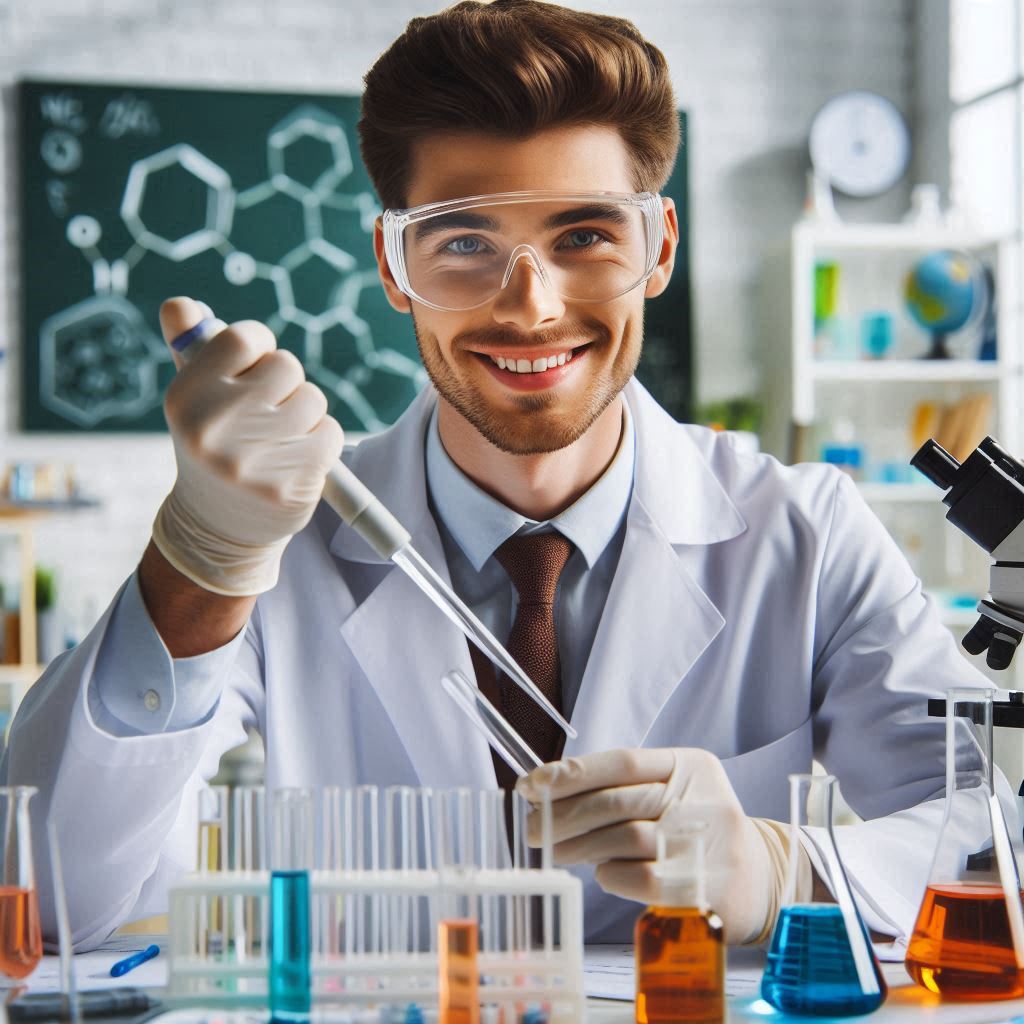
Minimize Fire Hazards
Importance of Knowing the Location of Fire Extinguishers and Emergency Exits
Knowing the location of fire extinguishers and emergency exits is crucial for laboratory safety.
In the event of a fire, quick access to extinguishers and exits can prevent injuries and damage to property.
Technicians should familiarize themselves with the layout of the lab and the placement of fire safety equipment to be prepared for emergencies.
How to Prevent Fires by Keeping Work Areas Clean and Clutter-Free
One of the best ways to minimize fire hazards in the lab is to maintain clean and clutter-free work areas.
Combustible materials should be properly stored and disposed of, and workspaces should be regularly cleaned to remove any potential ignition sources.
By keeping the lab tidy, technicians can reduce the risk of fires and create a safer working environment.
Steps to Take in Case of a Fire Emergency in the Lab
In the event of a fire emergency, technicians should remain calm and follow established protocols to ensure their safety and the safety of others.
If a fire breaks out, the following steps should be taken:
- Alert others in the lab by activating the fire alarm.
- Evacuate the building immediately using the nearest emergency exit.
- Do not use elevators during a fire emergency.
- If trained, use a fire extinguisher to suppress small fires.
- Call emergency services once safely outside the building.
By being prepared and knowing how to respond to a fire emergency, technicians can help prevent injuries and minimize damage in the laboratory.
Read: CAD Technician Salary: What to Expect in the USA
Practice Good Hygiene
Good hygiene practices are essential for laboratory technicians to maintain a safe working environment.
Here are some important considerations:
Importance of Washing Hands
- Always wash your hands before and after working in the lab
- Use soap and water to thoroughly clean hands to prevent cross-contamination
- Proper hand hygiene reduces the risk of spreading harmful pathogens
How to prevent contamination by avoiding touching face and eating in the lab
- Avoid touching your face, especially eyes, nose, and mouth, in the lab
- Avoid eating, drinking, or applying cosmetics in the lab to prevent contamination
- Dispose of gloves after use and wash hands before touching any surfaces
Reporting Illnesses or Symptoms
- If you feel unwell or exhibit any symptoms, report it to the supervisor immediately
- Stay home if you are sick to prevent the spread of infections to colleagues
- Follow proper protocols for notifying relevant personnel about any health concerns
By practicing good hygiene, laboratory technicians can help maintain a safe and healthy workspace for themselves and their colleagues.
Communicate with Team Members
Clear communication in the lab is crucial for preventing accidents and ensuring everyone’s safety.
Technicians often work with hazardous chemicals, sharp instruments, and sensitive equipment.
Any miscommunication can lead to serious injuries or damage.
By maintaining open lines of communication, you can help your team stay aware of potential risks and work more efficiently.
Remember, a well-informed team is a safer team.
Importance of Clear Communication with Colleagues to Prevent Accidents
Effective communication among lab technicians is essential to prevent accidents.
Misunderstandings can occur easily in a fast-paced lab environment.
For example, if one technician is unaware of a chemical spill, they might walk through it, causing a slip or exposure.
Clear communication ensures that all team members are aware of ongoing tasks, potential hazards, and safety procedures.
By sharing information regularly, technicians can avoid unnecessary risks and keep the lab environment safe for everyone.
How to Discuss Potential Hazards and Safety Protocols with Team Members
Discussing potential hazards and safety protocols should be a routine part of lab operations.
Before starting any new experiment or procedure, take a few minutes to brief your team on the risks involved.
This includes identifying hazardous substances, equipment, or procedures that could cause harm.
Use clear, direct language to ensure everyone understands the safety measures in place.
Encourage team members to ask questions if anything is unclear.
Open discussions about safety not only prevent accidents but also foster a culture of safety within the lab.
Regularly revisiting safety protocols keeps them fresh in everyone‘s mind, further reducing the risk of accidents.
Importance of Reporting Any Safety Concerns to Supervisors or Safety Officers
Reporting safety concerns is a critical responsibility of every lab technician.
If you notice a potential hazard, such as a malfunctioning piece of equipment or a spill that hasn’t been cleaned up, it‘s important to report it immediately.
Delaying or ignoring these concerns can lead to accidents or even more serious incidents.
Supervisors and safety officers are there to address these issues and implement corrective measures.
By reporting concerns promptly, you contribute to a safer working environment for everyone.
Additionally, regular reporting can help identify patterns or recurring issues that might require further attention or changes in protocols.
In essence, communication is the cornerstone of laboratory safety.
By ensuring clear communication with colleagues, discussing potential hazards and safety protocols, and reporting any safety concerns promptly, lab technicians can significantly reduce the risk of accidents.
Remember, a proactive approach to communication not only protects you but also your entire team.
Attend Regular Safety Training
Attending regular safety training sessions is crucial for laboratory technicians.
These sessions are designed to keep you updated on the latest safety protocols and procedures.
As laboratory environments evolve, so do the risks associated with them.
Staying informed about new hazards and how to mitigate them is essential for maintaining a safe workplace.
Safety training sessions provide you with the knowledge to handle chemicals, equipment, and other potential hazards effectively.
They also refresh your memory on existing protocols, ensuring that safety remains a priority in your daily tasks.
Importance of Attending Safety Training Sessions to Stay Updated on Protocols
Regular participation in safety training sessions helps you stay current with updated safety protocols.
The laboratory is a dynamic environment where new technologies and methods are constantly being introduced.
These advancements can bring about new safety challenges that require updated knowledge and practices.
By attending these sessions, you ensure that you are aware of the latest safety standards and how to implement them.
This proactive approach reduces the risk of accidents and ensures that you are prepared to handle any situation that may arise in the laboratory.
How to Participate in Drills and Exercises to Prepare for Emergencies
Participating in drills and exercises is an effective way to prepare for emergencies.
These practical exercises simulate real-life scenarios, allowing you to practice your response in a controlled environment.
Regular participation in these drills helps you develop the skills and confidence needed to react swiftly and correctly during an actual emergency.
Whether it‘s a chemical spill, fire, or other lab-related incident, knowing how to respond can significantly reduce the impact of the emergency.
Being familiar with emergency procedures ensures that you can protect yourself and your colleagues effectively.
Encouragement to Seek Additional Training or Certification in Laboratory Safety
Seeking additional training or certification in laboratory safety is a worthwhile investment in your career.
While regular safety training sessions are essential, pursuing further education can enhance your expertise.
Advanced safety courses offer in-depth knowledge on specific hazards and how to manage them.
Obtaining certifications in laboratory safety not only broadens your skill set but also demonstrates your commitment to maintaining a safe working environment.
This dedication to safety can set you apart in your career and lead to opportunities for advancement.
Continuous learning in laboratory safety ensures that you are always prepared for any challenge.
In a nutshell, attending regular safety training is vital for laboratory technicians.
Staying updated on protocols, participating in emergency drills, and seeking additional training all contribute to a safer laboratory environment.
By prioritizing safety, you protect not only yourself but also your colleagues and the integrity of your work.
Explore Further: Top Companies Hiring Marine Engineers in the U.S.
Gain More Insights: Top Networking Events for Telecommunications Technicians
Find Out More: Essential Tools for Environmental Technicians
Gain More Insights: Understanding CAD Technician Job Descriptions
Showcase Your Business Today
Reach thousands of readers actively exploring professional services. Publish your business profile and grow your audience now.
Publish NowConclusion
Laboratory Safety Tips for Technicians
As a laboratory technician, safety should always be your top priority during all activities.
Wear appropriate personal protective equipment, including gloves, goggles, and lab coats.
Always follow proper procedures and protocols when handling chemicals and equipment.
Ensure that all work areas are clean and organized to prevent accidents and spills.
Be cautious when using open flames or heat sources, and never leave them unattended.
Dispose of hazardous waste properly in designated containers to prevent contamination.
Label all containers with clear, accurate information to avoid confusion and potential hazards.
Regularly inspect equipment for any signs of damage or wear, and report any issues immediately.
Keep emergency contact information readily available in case of accidents or spills.
Stay informed about the specific safety guidelines and protocols in your laboratory setting.
In closing, prioritizing safety is essential for laboratory technicians to prevent accidents and ensure a safe working environment.
Recap of key safety tips
wear protective gear, follow procedures, keep work areas clean, and dispose of waste properly.
Remember to share safety tips with colleagues to promote a culture of safety in the workplace.
[E-Books for Sale]
The Big Book of 500 High-Paying Jobs in America: Unlock Your Earning Potential
$19.99 • 500 High-Paying Jobs • 330 pages
Explore 500 high-paying jobs in America and learn how to boost your career, earn more, and achieve success!
See All 500 High-Paying Jobs of this E-Book
1001 Professions Without a Degree: High-Paying American Jobs You Can Start Now
$19.99 • 1001 Professions Without a Degree • 174 pages
Discover 1001 high-paying jobs without a degree! Unlock career tips, skills, and success strategies for just $19.99!

